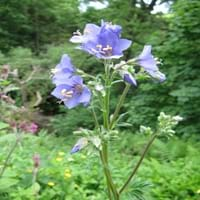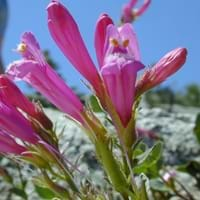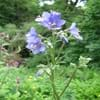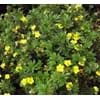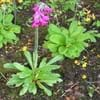Life Span
Perennial
Perennial
Origin
Hybrid origin
Southwestern United States, Mexico
Types
Not Available
Not Available
Habitat
Cold Regions, Temperate Regions
Wild
USDA Hardiness Zone
4-8
8-10
Sunset Zone
1a, 1b, 2a, 2b, 3a, 3b, 4, 5, 6, 7, 8, 9, 10, 11, 14, 15, 16, 17
10, 11, 12, 13
Habit
Cushion/Mound-forming
Clump-Forming
Flower Color
Blue, Lavender
Hot Pink
Flower Color Modifier
Not Available
Bicolor
Fruit Color
Non Fruiting Plant
Brown
Leaf Color in Spring
Green, Purple
Blue Green, Gray Green
Leaf Color in Summer
Green, Purple
Blue Green, Gray Green
Leaf Color in Fall
Green, Purple
Blue Green, Gray Green
Leaf Color in Winter
Light Green
Not Available
Leaf Shape
Linear
Lance shaped
Plant Season
Spring, Summer, Fall
Spring, Winter
Sunlight
Partial Sun, Partial shade
Full Sun
Type of Soil
Clay, Loam, Sand
Sand
The pH of Soil
Acidic, Neutral, Alkaline
Neutral, Alkaline
Soil Drainage
Average
Well drained
Bloom Time
Early Spring, Spring, Late Spring, Early Summer
Early Spring, Spring, Late Spring, Late Winter
Tolerances
Drought
Not Available
Where to Plant?
Container, Ground
Container, Ground
How to Plant?
Seedlings
Seedlings
Plant Maintenance
Medium
Medium
Watering Requirements
Average Water Needs, Keep ground moist, Water more in summer
occasional watering once established
In Summer
Lots of watering
Lots of watering
In Spring
Moderate
Moderate
In Winter
Average Water
Average Water
Soil pH
Acidic, Neutral, Alkaline
Neutral, Alkaline
Soil Type
Clay, Loam, Sand
Sand
Soil Drainage Capacity
Average
Well drained
Sun Exposure
Partial Sun, Partial shade
Full Sun
Pruning
Remove damaged leaves, Remove dead branches, Remove dead leaves
Remove damaged leaves, Remove dead branches, Remove dead leaves
Fertilizers
All-Purpose Liquid Fertilizer, as it is a flowering plant, use high phosphorous content fertilizer
All-Purpose Liquid Fertilizer
Pests and Diseases
Red blotch
Red blotch
Plant Tolerance
Drought
Drought
Flower Petal Number
Single
Single
Foliage Texture
Fine
Medium
Foliage Sheen
Matte
Matte
Attracts
Butterflies
Hummingbirds
Allergy
Not Available
poisonous if ingested
Aesthetic Uses
Beautification, Showy Purposes
Borders, Showy Purposes
Beauty Benefits
Not Available
Not Available
Environmental Uses
Air purification
Air purification
Medicinal Uses
Black Dyes, Not Available
constipation, Stomach pain, Swelling, Wounds
Part of Plant Used
Not Available
Flowers, Leaves, Stem
Other Uses
Not Available
Showy Purposes, Used as Ornamental plant
Used As Indoor Plant
Yes
Yes
Used As Outdoor Plant
Yes
Yes
Garden Design
Feature Plant, Mixed Border, Rock Garden / Wall, Wildflower
Cutflower, Mixed Border, Rock Garden / Wall, Wildflower
Botanical Name
Polemonium caeruleum
PENSTEMON parryi
Common Name
Jacob's Ladder
Parry's Beardtongue
In Hindi
Jacob's Ladder
penstemon parryi
In German
Jacob's Ladder
penstemon parryi
In French
Jacob's Ladder
penstemon parryi
In Spanish
Jacob's Ladder
parryi penstemon
In Greek
Jacob's Ladder
penstemon parryi
In Portuguese
Jacob's Ladder
parryi penstemon
In Polish
Jacob's Ladder
penstemon parryi
In Latin
Jacob's Ladder
Persicaria californicum
Phylum
Tracheophyta
Magnoliophyta
Class
Magnoliopsida
Magnoliopsida
Family
Polemoniaceae
Scrophulariaceae
Genus
Polemonium
Penstemon
Clade
Angiosperms, Asterids, Eudicots
Angiosperms, Asterids, Eudicots
Tribe
Not Available
Not Available
Subfamily
Not Available
Not Available
Number of Species
Not Available
Properties of Jacob's Ladder and Penstemon Parryi
Wondering what are the properties of Jacob's Ladder and Penstemon Parryi? We provide you with everything About Jacob's Ladder and Penstemon Parryi. Jacob's Ladder doesn't have thorns and Penstemon Parryi doesn't have thorns. Also Jacob's Ladder does not have fragrant flowers. Jacob's Ladder has allergic reactions like Not Available and Penstemon Parryi has allergic reactions like Not Available. Compare all the properties and characteristics of these two plants. Find out which of these plant can be used as indoor plant. If you are interested to decorate your house and garden, find out aesthetic uses, compare them and select the plant which will beautify your surrounding. Along with beautification, try comparing medicinal and edible uses of Jacob's Ladder and Penstemon Parryi and you can choose the plant having best and most benefits.
Season and Care of Jacob's Ladder and Penstemon Parryi
Season and care of Jacob's Ladder and Penstemon Parryi is important to know. While considering everything about Jacob's Ladder and Penstemon Parryi Care, growing season is an essential factor. Jacob's Ladder season is Spring, Summer and Fall and Penstemon Parryi season is Spring, Summer and Fall. The type of soil for Jacob's Ladder is Clay, Loam, Sand and for Penstemon Parryi is Sand while the PH of soil for Jacob's Ladder is Acidic, Neutral, Alkaline and for Penstemon Parryi is Neutral, Alkaline.
Jacob's Ladder and Penstemon Parryi Physical Information
Jacob's Ladder and Penstemon Parryi physical information is very important for comparison. Jacob's Ladder height is 20.30 cm and width 27.90 cm whereas Penstemon Parryi height is 90.00 cm and width 5.10 cm. The color specification of Jacob's Ladder and Penstemon Parryi are as follows:
Jacob's Ladder flower color: Blue and Lavender
Jacob's Ladder leaf color: Green and Purple
Penstemon Parryi flower color: Hot Pink
- Penstemon Parryi leaf color: Blue Green and Gray Green
Care of Jacob's Ladder and Penstemon Parryi
Care of Jacob's Ladder and Penstemon Parryi include pruning, fertilizers, watering etc. Jacob's Ladder pruning is done Remove damaged leaves, Remove dead branches and Remove dead leaves and Penstemon Parryi pruning is done Remove damaged leaves, Remove dead branches and Remove dead leaves. In summer Jacob's Ladder needs Lots of watering and in winter, it needs Average Water. Whereas, in summer Penstemon Parryi needs Lots of watering and in winter, it needs Average Water.
